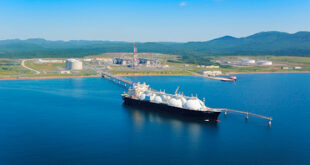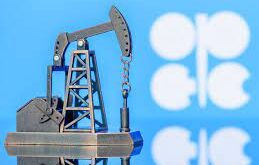Faced with high energy prices and the urgent need to break away from Russian fossil fuels, the European Commission is doubling down on the roll-out of renewables and energy efficiency measures.
The war in Ukraine has led to a monumental shift in EU climate policy. Within weeks of the invasion, Europe announced it would cut its reliance on Russian gas by two thirds before the end of the year.
Europe is reliant on Russia for 40% of its gas, importing 155 billion cubic metres (bcm) every year. On 8 March, the European Commission outlined its plan to address this: REPowerEU.
The plan is twofold. First, the EU aims to increase energy efficiency and the rollout of renewable energy. But because not all industries can be electrified and there is still a high demand for gas in the near future, the second part looks at diversifying Europe’s gas supply.
In the short term, this means turning to other suppliers, particularly liquified natural gas (LNG) from the US and Qatar. In the longer term, it means ramping up the production of renewable or low-carbon gases, like biomethane and “clean” hydrogen.
“It is time we tackle our vulnerabilities and rapidly become more independent in our energy choices. Let’s dash into renewable energy at lightning speed,” said EU Green Deal chief Frans Timmermans.
“Renewables are a cheap, clean, and potentially endless source of energy and instead of funding the fossil fuel industry elsewhere, they create jobs here. Putin’s war in Ukraine demonstrates the urgency of accelerating our clean energy transition,” he added.
Energy security
According to the European Commission, the EU has enough gas to make it through this winter, even if Russia were to switch off the tap. The main question now is what to do ahead of next winter.
“The real problem would be filling storage in spring and summer, in preparation for winter 2022-2023,” said Catherine MacGregor, the chief executive of Engie, the French energy utility. “It would be very difficult to find the necessary volumes and it would be very hard in the event of a long conflict in Ukraine.”
To be prepared for next winter, countries should start filling their storage now, according to the European Commission.
On Wednesday (23 March), the EU executive plans to table a legislative proposal to ensure gas storage in Europe is filled at least up to 90% every year ahead of the winter season. The proposal would also look at fairness between EU countries as different member states have different storage capacities.
Beyond storage, Europe also needs to find alternative suppliers to replace Russian gas. The industry has already started shifting to this, with imports of LNG hitting historic highs in December and January.
According to the European Commission, Europe could import 50 bcm more per year from suppliers like Qatar, the US, Egypt and West African countries. Diversifying the gas delivered to the EU via pipelines from countries like Azerbaijan, Algeria and Norway could deliver another 10 bcm annually.
The EU executive also wants to look beyond fossil gas to renewable gases, like biomethane and green hydrogen. It started putting Europe on course to increase production of renewable gases with legislative proposals tabled in July and December, but the war in Ukraine has made this more urgent.
Under its REPowerEU plan, the European Commission wants to reach 35 bcm of biomethane production and 20 million tonnes of green hydrogen production and imports by 2030.
If it hit these objectives, Europe would shed 3.5 bcm of Russian gas by the end of 2022 and 43-68 bcm of Russian gas by 2030, according to the Commission’s estimates.
However, this requires a huge increase in production. At the moment, Europe produces around 17 bcm of biogas, around 3 bcm of which is biomethane – a higher quality gas that can be injected straight into the grid.
Meanwhile, over 90% of hydrogen is currently still produced from fossil fuels like natural gas, and green hydrogen production volumes are not expected to become significant before the 2030s.
Stumbling blocks
The 35 bcm objective for biomethane is welcomed by the industry. Trade association Eurogas said a target will help drive production by giving an indication of how much Europe wants and by when.
But one concern is how these objectives would be supported by legislation.
“All the vehicles have left the garage – the renewable energy directive is out, the gas directive is out,” said James Watson, the secretary-general of Eurogas.
“In this respect, the Commission will have to work out how they’re going to put those ideas in the communication into practice and it’s far from clear to us how that will happen,” he told EURACTIV.
Another concern is that not all the pieces of the puzzle are in place yet. For instance, there is confusion in the gas package when it comes to whether biogas is counted as renewable or not.
Alongside this, the industry will have to wait until 2024 for clarification on low-carbon gases, which the industry warns could mean delays in investment decisions.
There are also concerns that the slow rollout of renewable energy in Europe will prove a stumbling block for renewable hydrogen, which relies on green energy to power the process.
“Renewable hydrogen very much depends on the ability to have the rollout of renewable electricity and, therefore, overcoming things like permitting,” said Watson.
“The build-up of renewables isn’t going anywhere near fast enough even to meet the direct electrification objectives that there are, let alone to also provide the green hydrogen,” he added.
This would leave Europe more reliant on its international partners for green hydrogen.
However, there are also issues around infrastructure for imports, which could impact the supply of both LNG and hydrogen. Every EU country is now linked directly or indirectly to an LNG terminal, but there are gaps in the system.
For instance, the Iberian Peninsula has several LNG import terminals, with Portugal seeking to position itself as Europe’s “new gateway for gas” imported from places like the US and Qatar. However, it is cut off from the rest of Europe because there is no pipeline infrastructure connecting France to Spain. This “critical” connection should be prioritised, according to the European Commission.
Environmental groups, for their part, warn against building new gas infrastructure, saying LNG terminals and pipeline connections will take years to complete and won’t alleviate the immediate pressure on gas supply.
By doing so, Europe risks locking itself into a new fossil gas addiction, they warn, pointing to the environmental impact of fracked LNG coming from the US and poor human rights record of countries like Qatar and the United Arab Emirates (UAE).
Like the European Commission, environmental groups also emphasise the need to electrify as much as possible.
“Both renewable hydrogen and biomethane will play a limited role in the energy transition, and can play a limited role in the short term,” Eilidh Robb from Friends of the Earth told EURACTIV.
“We need to be sure that hydrogen usage is renewable and used primarily for sectors that are hard to electrify, and we must be realistic about the volumes of biomethane being proposed, particularly given the already rising cost of food,” she added.
Renewables and energy efficiency
Renewable energy and energy efficiency have also been thrown into the spotlight as ways to decrease Europe’s reliance on Russian fossil fuels.
The EU was already looking to increase its renewable energy capacity and boost energy efficiency to tackle the climate crisis, with new targets tabled in July.
The need to break away from Russian fossil fuels has made these even more pressing. “Given the circumstances, the co-legislators might also want to consider….higher or earlier targets for renewable energy and energy efficiency,” the Commission says in its REPowerEU plan, something already underway in the European Parliament.
On renewable energy, the European Commission wants to increase the rollout of solar power and heat pumps. In June, it plans to table a communication on unlocking solar energy’s potential as a major renewable energy source and, in May, it is expected to publish a recommendation on fast permitting for renewables.
Under its ‘Fit for 55’ package of climate legislation tabled in July, Europe’s solar and wind capacities would double by 2025 and triple by 2030, cutting annual gas consumption by 170 bcm by the end of the decade. Speeding up the rollout of rooftop solar could save an additional 2.5 bcm of gas.
Impact on consumers
For EU governments, high energy prices and the impact on consumers is a huge concern. To help alleviate this, many energy companies are favourable to a Europe-wide cap on gas prices to contain volatility.
Electricity prices are driven by “marginal” production capacity available from gas power plants whose cost have surged since last summer because of a supply squeeze from Russia and lack of storage.
“As a matter of urgency, I think it’s really important that we take a look at capping wholesale gas prices at European level. That will make it possible to contain the volatility,” Engie’s MacGregor told a panel hosted by the French government on 9 March.
But Engie also warns against making drastic changes to Europe’s electricity market in an attempt to alleviate the price crunch.
“People are somehow confusing the need for immediate emergency measures in order to control prices in case of gas supply disruption – this is exactly what we’re saying regarding a cap on wholesale gas prices – and the option to improve further the European electricity market design, which is related to the demand, the available generation and its marginal production cost, often linked to CO2 and gas level,” said Guillaume Gillet, director of European Affairs at Engie.
“We are very cautious with this latter aspect because that’s something that has been developed and working for 25 years,” he told EURACTIV.
Energy companies also warn against a drastic reassessment of the role of gas in the energy transition. Once envisaged as a transition fuel for coal-reliant countries like Poland and Germany, the narrative around fossil gas has changed dramatically since the outbreak of war in Ukraine.
Warsaw is now looking at “how we can reduce our dependence on gas during this transitional period,” said Polish climate minister Adam Guibourgé-Czetwertyński during a meeting of environment ministers on Thursday (17 March). “We’re going to have to reconsider the plans that we had forged in the past,” he admitted.
Europe’s largest gas consumer, Germany, is also reconsidering gas as a transition fuel. “Putin has broken the narrative of natural gas as a bridging technology, the bridge has collapsed,” said Patrick Graichen, state-secretary at the German ministry for economic affairs and climate action.
For environmental groups too, the war in Ukraine has shown Europe’s overdependence on fossil fuels. According to Robb, Europe now needs a serious plan to phase out gas, alongside measures to protect vulnerable consumers, like a ban on disconnections.
However, in the eyes of industry groups like Eurogas, fossil gas still has a role in the energy transition, even if it is a shorter bridge towards renewables.
Gas will still be needed, particularly for low-carbon hydrogen production, Watson told EURACTIV, pointing to countries like Norway, which still have large reserves of fossil gas and are developing carbon capture technology to tackle the related emissions.
“There’s, of course, the discussion of reducing dependency on Russia, but at the same time, we shouldn’t lose the innovation that we will need to meet our climate objectives,” said Watson.

 Iran Energy News Oil, Gas, Petrochemical and Energy Field Specialized Channel
Iran Energy News Oil, Gas, Petrochemical and Energy Field Specialized Channel



